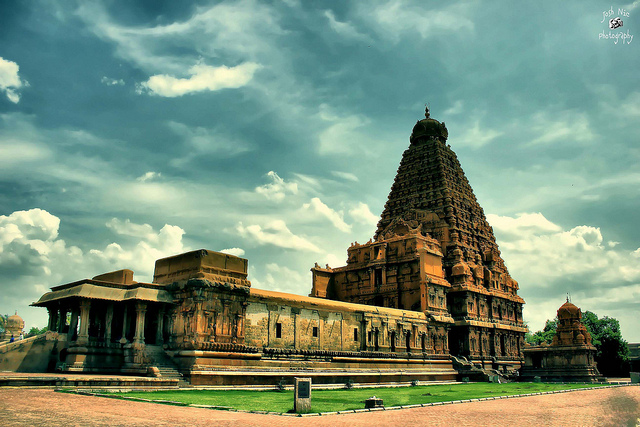
Standing Magnificiently after 1000 Years
Brihadeeshwarar temple – popularly known as “Thanjavur Periya Kovil”– is the largest temple in India and is one of the greatest temples with an outstanding architecture in the country. The temple dedicated to the major Hindu deity, Lord Shiva, was built in 1010 AD by the Chola Emperor, Rajaraja Chola I. The temple represents the brilliancy and excellence of Cholas who scaled major heights in large scale as well as intricate architecture. The magnificent edifice not only has sculptures, a majestic Vimana (temple tower) and frescoes, but also has inscriptions disclosing the richness and wealth of Tamil people during those days. The temple has survived the ravages six recorded earthquakes and a major fire. UNESCO has declared it a World Heritage Monument.
The Thanjavur Periya Kovil is located in Thanjavur district in Tamilnadu, India. The temple was built on the banks of River Cauvery with its water turned to the moat. The temple, constructed entirely of granite, stands amidst fortified walls. There was no rock formation around this area. It is believed that the rocks would have been brought from a place at least 50kms away.
Arulmozhivarman, the Tamil emperor, popularly known as Rajaraja Chola I, ruled entire South India, east and a part of the western coast, Ceylon (Sri Lanka), Srivijaya, Malaya and the Maldives islands. He was also known as Sivapada Sundaran meaning ‘a man devoted to the feet of Shiva’. He laid the foundations for the temple in compliance with the command received in his dreams when he was crowned as an emperor in Sri Lanka. The Chola originally named the temple as “Rajarajeswaram” and he conducted all important festivals. The Thanjavur Periya Kovil and the capital had close business relations with the rest of the country and acted as a centre of both religious and economic activity. Villages from all over the country supplied men and material for the maintenance of the temple.
The Thanjavur Periya Kovil has been designed using traditional knowledge, which was held secret. The Marathas and Nayakas who later invaded Thanjavur christened the temple as “Brihadeeshwarar temple” and it has remained an icon of Tamil culture.
Thanjavur Periya Kovil is almost 40 times bigger than that of any known temple of its time. The magnificent Vimana (temple tower) stands to a height of 216 feet (66m) and it is one among the tallest towers in the world. Standing to such a great height, Vimana, reveals the particulars of the temple through the inscriptions left by the King himself. The tower was built hollow by the master designers. The big statue of Nandhi (sacred bull), measuring about 16 feet long and 13 feet high is present at the entrance and it is made up of a single rock. The octagonal Shikharam weighs 81 tons. Huge Nandis dot the corners of the Shikharam and the Kalasam on top is about 3.8 meters in height. The Shivalingam measures up to 3.7m, set in a two storeyed sanctum.
The inscriptions were the master work done by the king. It contains 107 paragraphs instructed by him seated in the royal bathing hall at the eastern side of his palace. The instructions were provided for carving the details like, how his order should be adorned at the base of Vimana, how he executed the plan for construction of the temple, the list of gifts given by him, his sister and by others to the temple, including a list of 66 beautiful bronze idols. It is a sad fact that only two bronze idols are available in the temple today – one that of a dancing Shiva and another of his consort Sivagami.
After the death of the patron, Rajaraja Chola I, his son Rajendra I who was a great military leader succeeded him. During his reign, he extended the territory of already vast Chola Empire. He shifted the capital of the Chola kingdom to Gangaikondacholapuram and started building a new temple there, as he wanted to build a bigger version of “The Big Temple”. Rajaraja Chola I donated a big amount of money for the maintenance of the Periya Kovil. But, Rajendra I had diverted all the money for the construction of his new temple. His decision deprived the Big Temple of royal patronage. However, Rajendra was able to build only a smaller version of the Big Temple, eventually. Further more, the Cholas built hundreds of temples along the banks of the River Cauvery.
Thanjavur Periya Koil is the grandest creation of Cholas and it is visible from any area in Thanjavur.This temple is part of the UNESCO World Heritage Site “Great Living Chola Temples”. The temple became popular all over the country on its 1000th birthday in September 2010. In its commemoration, a rupees postage stamp, featuring the 216-feet tall Raja Gopuram (Vimana) was released by the India Post. A 5 rupee coin was released by the Reserve Bank of India. A 1000 Rupees Commemorative Coin (with the same picture on the 5 rupees coin) of Thanjavur Periya Kovil will be issued soon. This will be the first 1000 Rupees coin to be released in the Republic of India coinage, but it will not be for public circulation (In April 1954, the Reserve Bank of India had released a 1000 rupees currency note with panoramic view of the temple. Later, during the Indira Gandhi rule, all 1000 rupees notes were demonetized to curtail black money.
No comments:
Post a Comment